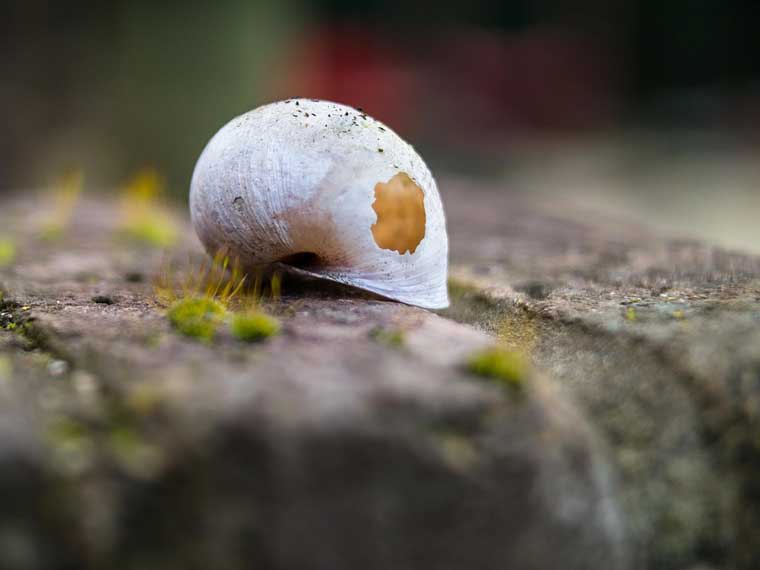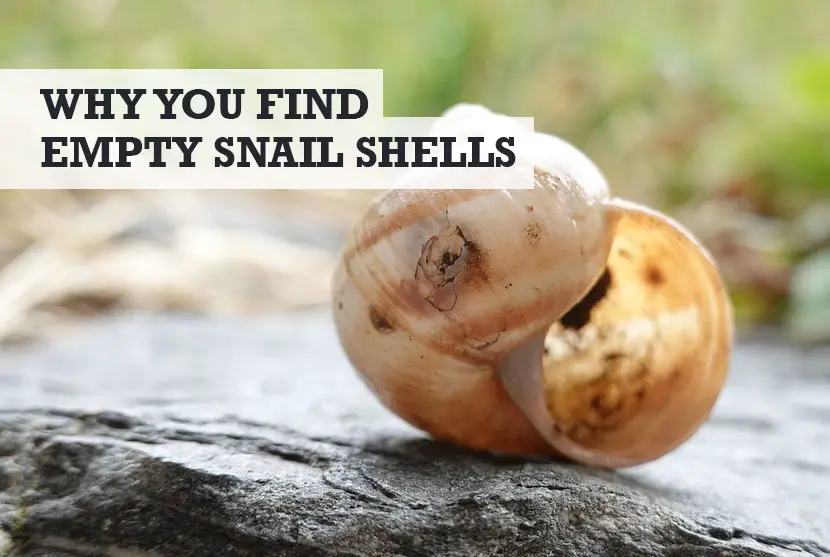Last summer I could not get over how many empty snail shells there were in my backyard. There were upwards of twenty empty shells in a corner of the garden. I could not figure out where they all came from… until I did my own research. If you keep finding empty snail shells in your garden, here’s what I found out about why this happens.
Why are there so many empty snail shells in my garden? You will find empty snail shells in your garden due to predators eating them, such as birds and rodents. Sudden cold weather can also kill snails, plus parasitic infections.
That’s a very short answer but there’s more to it, as depending on the state of the shell, you could do some detective work and figure exactly what happened.
Why you find empty snail shells in your garden and backyard
As discussed, there are a few different reasons for finding empty snail shells in your garden including predators, weather, and possible disease. You might be able to figure out exactly what was eating or killing the snails though – here’s how.
1. Beetles
When beetles prey on snails, they don’t break the shell. I believe they use their claw to pick the snail out before eating it. Leaving a whole empty snail shell behind.
2. Parasites
Similarly, a parasitic snail infection could affect a whole colony. Once the snails have died, they will either shrivel up leaving empty shells in your yard, or other pests will then come and clean up the bodies.
For example, once the snails are dead, ants might take the flesh away leaving just the empty shells behind.
3. Birds
Different birds have different ways of killing snails. Some birds will pick up snails and drop them onto concrete to smash them. You see this behaviour near coastal areas where gulls have learned how to do the same with shells from the sea.
But then other birds like the Blackbird, Robin, and Song Thrush can swoop down on a snail when it’s extended from the shell feeding. They will grab the mollusc flesh and be able to pull it out and eat it without damaging the shell at all.
In most cases though, birds will smash and peck, so a solitary empty snail shell could point towards a bird being a predator.
4. Rodents
If you find a collection of empty snail shells in a hiding place in your backyard garden, the culprit could be rodents. I’ve seen this in my friend’s garden when decking was lifted up, there were hundreds of snail shells there which had been taken there to eat by rats.
Rats will bite a small hole in a snail shell, and then suck the snail out.

5. Weather changes
Snails can also become susceptible to weather. Something like a sudden cold snap can cause mass deaths in snails, leading to a collection of empty snail shells in your garden.
It’s also worth noting that one snail can lay up to 2,000 eggs in a lifetime. That’s a lot of snails. When you combine that with the fact that a snail shell can take more than 10 years to disintegrate after death, you might find that lots of empty snail shells have accumulated in your backyard over the years.
At the locations and habitats studied, decomposition rate of snails averaged 6.4% per year, excluding shells that broke during the experiment (shell half life = 11.5 years), or 10.2%, including shell breakage (half life = 7.5 years). Half lives would likely be shorter if macro-grazers had access to shells.
BioOne Complete, http://www.bioone.org/doi/abs/10.4003/006.026.0211
What does finding an empty snail shell mean?
In conclusion then, finding an empty snail shell in your garden or backyard could mean a clever predator has got it, disease, or simply natural causes.
More about snails in your garden
You are most likely to find a snail in your backyard or garden after it has rained on a cloudy day or at night. Snails are born with shells, and as they grow older, the shells become more prominent and more robust.
The shell aims to protect the snail from harsh weather conditions such as extreme sunlight and harsh winter.
Also, the shell does offer some protection from predators such as rodents, birds, and amphibians. But as we’ve established, some predators are simply too much for a snail, which is why you find those empty snail shells in your garden.
Do snails completely leave their shells?
No, they can’t come out completely as they are attached, but they can extend out quite a way. They will do this when looking for food, travelling, and mating – and it’s when they extend from the shell that they are most vulnerable to predators.
In the presence of a threat, the snail retracts fully into its shell. However, most predators can easily break into the shell of the snails. Snails settle in protected environments to minimize this threat and only come out of their shells whenever necessary.
What can snail shells be used for in your garden?
When you find those empty snail shells in your garden, you can put them to good use.
The shells of snails are primarily made up of calcium carbonate. If you keep finding empty snail shells in your garden, you can crush them and spread them over the soil. Calcium carbonate neutralizes the soil, and this is good for plants.
In fact, this is very similar to seashells and how they can be used in gardening. Which reminds me, I also investigated the mystery of seashells appearing in gardens which offers some fascinating results.
But what if you don’t want snails in your garden?
How to get rid of snails in your backyard
Since snails feed on plants, they may wreak havoc in your garden or backyard; hence, you might not want them in your backyard, and welcome the empty snail shells.
One of the most effective ways of getting rid of snails is by employing biological methods. Birds such as chicken, ducks, or goose feed on snails and keeping them in your backyard or garden can help you get rid of snails effectively.
Also, you can use bait such as beer, a mixture of honey with yeast, or grape juice to attract the snails then you can capture dispose of them appropriately. Poisonous baits are also available, but this may affect other organisms in the ecosystem of your garden.
It is easy to make a trap at home; an inverted flowerpot can serve as a good trap. Inverted melons or cabbage leaves can also help to trap snails. The traps attract the snails, and they crawl into the traps. Leave the traps for an extended time in the infested area to trap as many pests as possible.
You can use killer substances such as salt and pesticide to control snails in your garden or backyard. Salt dehydrates the snails, hence killing them.
Garlic is also a killer substance for snails and is mixed with water then sprayed over the infested area. Iron phosphate is among the chemicals highly recommended to control snails since it can be used anywhere and is safe.
It does sound a little gruesome though, and in my garden, we leave the snails be to get on with their lives.
Conclusion
When you find one empty snail shell in your garden it will usually be one of many. It’s not at all unusual, and in most cases with a little detective work, you can figure out why they appeared.
So, the next time you find empty snail shells in your backyard, refer back to my points and see if you can figure out the culprit.
You might also like…
- Why you find toads in your garden even though you don’t have a pond
- How to use oyster shells in your garden soil successfully
Image in header via https://pixabay.com/photos/shell-stone-snail-animal-spiral-4380606/

